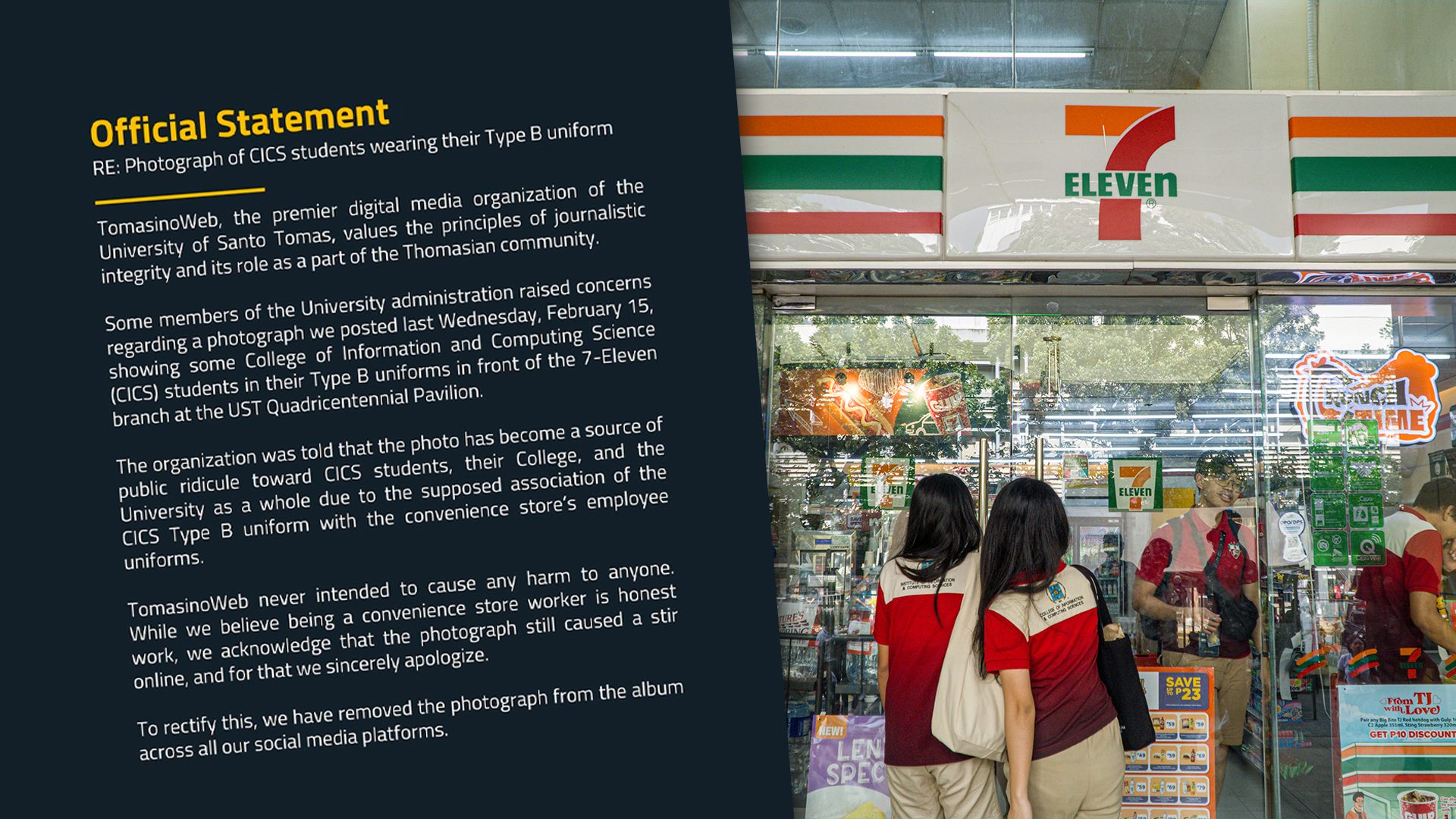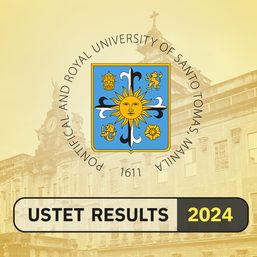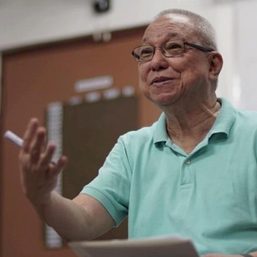SUMMARY
This is AI generated summarization, which may have errors. For context, always refer to the full article.

MANILA, Philippines – TomasinoWeb, the digital student media organization of the University of Santo Tomas (UST), temporarily stopped social media operations after the resignation of its publication adviser on Monday, February 19.

This comes after the university’s Office for Student Affairs (OSA) ordered the organization to delete a photo of students from the College of Information and Computing Sciences (CICS) entering a convenience store inside the campus. OSA said the image caused “public ridicule.”
The picture was a part of TomasinoWeb’s social media post on Thursday, February 15, which featured students from different colleges wearing their “Type B” uniforms, which are typically worn from Ash Wednesday until the end of the second semester.
According to a report by The Varsitarian, there were jokes that compared the Type B uniform of the CICS students to those of convenience store employees.
UST journalism instructor Leo Laparan II, who is also a desk editor at The Philippine Star, said in his resignation letter that “the recent turn of events has rendered my position in the student organization immaterial and insignificant moving forward.”
“I felt like I was trampled upon with what happened. Natapakan yung pagka-journalist ko sa nangyari because that is a clear illustration of censorship,” he told reporters in an interview.
Laparan will continue teaching journalism classes at the UST Faculty of Arts and Letters.
Fr. Louie Coronel, UST’s secretary-general, told Rappler in an email on Tuesday, February 20, that “collaborative efforts are being undertaken to resolve the matter,” and that they “value the inputs shared on various platforms” as these help them deliberate on the matter.
Not a publication
According to the Campus Journalism Act of 1991, having an adviser is only optional for student publications at the tertiary level.
But technically, TomasinoWeb is not a student publication. Under UST guidelines, they are classified as a student organization.
TomasinoWeb, like other student organizations, follows guidelines set by the OSA. Student publications, on the other hand, report to the Office of the Secretary-General.
According to rules laid out by the OSA, when the adviser of a student organization resigns, it should “cease to post anything until such time that a new adviser is appointed.”
Those who violate the policies may not be accredited to operate in the following academic year.
How does this technicality affect the work of a student media organization? For TomasinoWeb president Jan Carlo Zamora, this means that they have no true freedom as part of the campus press.
“We are not truly free to write and create content because we are subjected to checks by the office, while other student publications can be as expressive as they want,” he told Rappler in an interview.
Laparan shared the same sentiment, adding that until it could operate “devoid of external forces,” TomasinoWeb cannot fulfill its true purpose.
“I don’t think that it’s going to work because a media organization cannot fulfill its purpose, its duty to inform the public if there’s going to be intervention,” he said in a mix of English and Filipino.
‘A long standing fight for press freedom’
Zamora hopes that Laparan’s resignation will serve as a call for university officials to create an environment where students can freely express themselves, and organizations like TomasinoWeb can start discussions on pressing campus issues.
“His resignation, while a very huge loss to the organization, shall start a university-wide call for a better administration and for an environment where students can express themselves to their fullest,” he said. “TomasinoWeb has been in a very long standing fight for press freedom, only to end up like this.”
Miguel Angelo Sumalinog, the organization’s executive editor, also urged the public to help call for press freedom, as it “goes beyond the matter of the issue inside the campus but to a national level as well.”
But this is not the first time that UST’s student organizations have experienced intervention from university administrators.
Laparan said that in December 2023, the OSA flagged the organization’s post about the jeepney modernization program, saying that this could be misinterpreted as the university’s stand on the controversy.
Organizations also called out the university in 2020 for implementing stricter rules for social media posting. Back then, student leaders had to submit Permission to Post forms to their dean, Student Welfare and Development coordinator, and the OSA before releasing any publicity material or announcement online.
The Varsitarian said in a report that those who fail to comply with the requirement will be reprimanded, and their accreditation to operate may be suspended or revoked.
Processes like these, according to the National Union of Students in the Philippines, are “roundabout methods of legitimizing and extending student repression through online means.”
What happens now?
While they are looking for a new adviser, TomasinoWeb will continue to post updates on its website, especially during UAAP Season 86 and the upcoming student council elections in UST.
Its officers are also coordinating with its alumni and other press freedom advocates to discuss the next steps for their organization.
On Wednesday, February 21, hundreds of UST alumni signed a petition showing solidarity with TomasinoWeb and urging the university administration to end their “repressive, arbitrary, and outdated policies.”
“It is clear that what brought UST public ridicule is not TomasinoWeb’s photo but the university itself and its refusal to uphold and recognize students’ rights,” the petition said.
Interested alumni can still sign the petition through standwithtomasinoweb.com.
Progressive groups were also quick to show support for the student media. Just hours after Laparan’s resignation, student activists held a protest outside the university to call for campus press freedom.
Progressive groups were also quick to show support for the student media. Just hours after Laparan’s resignation, student activists held a protest outside the university to call for campus press freedom.
In a statement, the College Editors Guild of the Philippines slammed UST for its order, as well as its “long history of academic freedom violations and disregard of genuine student concerns.”
Meanwhile, the National Union of Journalists of the Philippines blasted UST for the imposed takedown and its “elitist stance,” urging them to protect press freedom and “uphold the dignity of work and honor the workers’ contributions to the Philippine society.”
The issue revived discussions on the amendment of the Campus Journalism Act, which has several flaws that compromise campus press freedom, including the lack of provisions protecting editorial independence.
In 2021, former Kabataan representative Sarah Elago renewed her push for House Bill No. 319 or the Campus Press Freedom bill, which hopes to better protect campus journalists and hold erring administrators accountable.
The bill was not passed into law. – Rappler.com
Add a comment
How does this make you feel?






![[OPINYON] Tungkol sa naging viral na social media conjecture](https://www.rappler.com/tachyon/2024/07/thought-leaders-conjecture-07262024.jpg?resize=257%2C257&crop_strategy=attention)

![[EDITORIAL] Apat na taon na lang Ginoong Marcos, ‘di na puwede ang papetiks-petiks](https://www.rappler.com/tachyon/2024/07/animated-bongbong-marcos-2024-sona-day-carousel.jpg?resize=257%2C257&crop=280px%2C0px%2C720px%2C720px)





There are no comments yet. Add your comment to start the conversation.